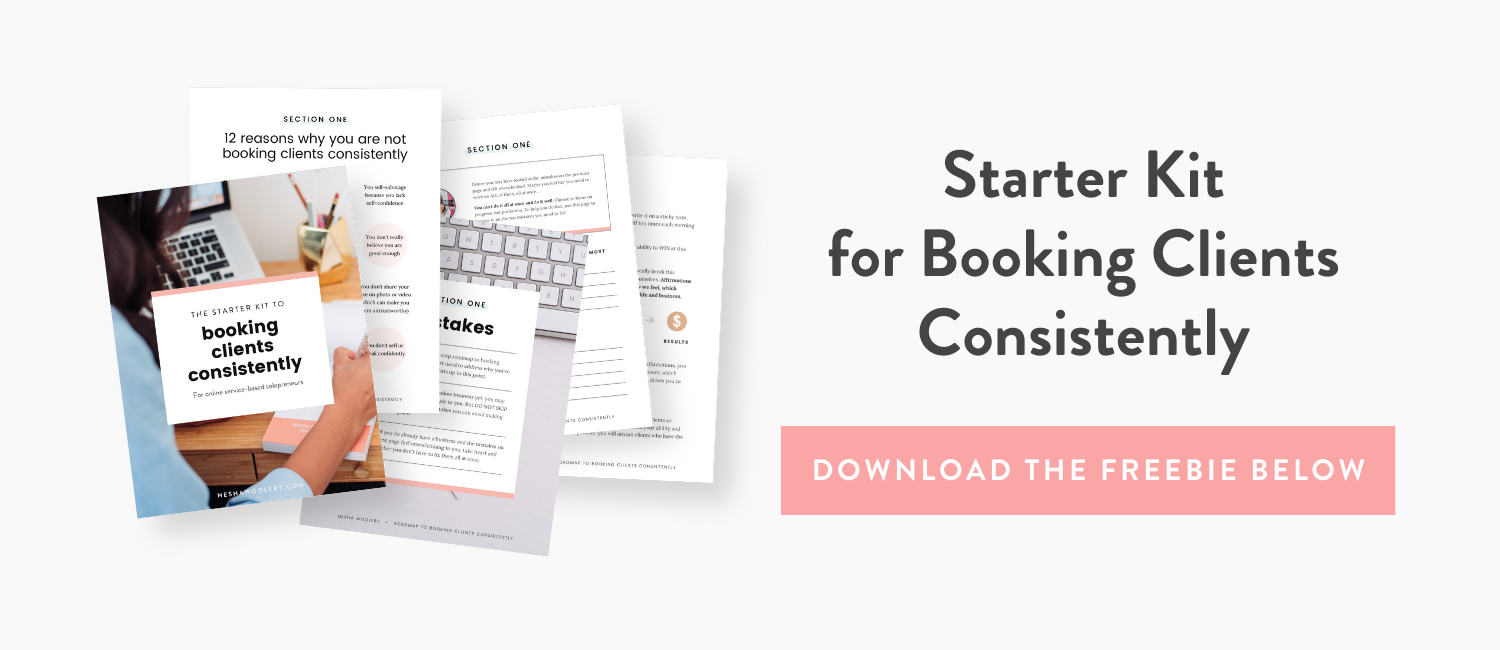Pricing Strategy For Freelance Designers
Let me ask you - do you have doubts about your prices?
Maybe you think you’re charging too little or too much.
Maybe you want to raise your prices but you’re worried that no clients will want to pay you that much money?
I understand, I’ve been there. I went from charging $50 for a blog to design to no less than $4000 - I know allll about the evolution of pricing and how scary it can be.
I want to help you figure out EXACTLY what you should be charging your design clients, and I want to help you feel confident about your prices.
That's why I'm bringing you this free 1-hour pricing workshop!
Watch the video or read on to learn how to strategically price your design services.
How to attract clients with bigger budgets
Do you struggle to find the right clients? Clients who value your expertise? Clients who can afford you?
Do you attract clients with tight budgets? People whose 'business' is more of a hobby?
Chances are that you answered yes to all of the above.
You don't feel like you can justify quitting your (well paid) day job when you can't find clients who can afford you.
And worse- if you've already quit and you're struggling to make a decent income from freelancing, you may be seriously contemplating finding a 'real job'. A boring 9-5 job that you know you'll hate, but you also know will safely pay your bills.
There's nothing wrong with finding a 9-5 job if you are really desperate. In fact, I put my hands up to the folks who do this! It takes guts and humility to surrender your dreams (for now) and go back to working in the corporate world.
But before you do that, I want you to try your very best to find the clients that can afford you. The clients with bigger budgets. Because they ARE out there. You just aren't attracting them yet.
Let me tell you the financial story of my business over the last few years.
Before I quit my day job...
I freelanced on the side, trying to build up my experience and portfolio.
I didn't have a website yet, or any testimonials. I only had my blog.
I targeted micro-businesses, like Etsy shop owners and bloggers. The problem with that is that the majority of Etsy shop owners and bloggers are hobbyists. This means that their budgets are really tight. I was only making about $340 per blog design.
What did I learn from this?
I worked my butt off for barely any money but I built up my portfolio and I got a few testimonials, which was well worth the hard work! Now I'd built a foundation for my business, I recognized that I needed to change my target client to businesses with bigger budgets.
In my first two years of freelancing full-time...
My rates were a bit higher than before, but still really low compared to the average wage of my peers. This most likely made me look like an amateur to prospective clients with bigger budgets, even if my work was good.
I decided to raise my rates again and steer away from bloggers and shop owners, focusing on female entrepreneurs with five/six figure businesses. I began charging $2000+. Here was the problem: I still didn't have enough experience to charge people this much.
To make matters worse, my website was terrible. It looked very corporate and attracted the wrong clients. It didn't contain much useful information- like my step-by-step process, testimonials, an about page, or a sign up form- which probably helped people decide not to hire me.
What did I learn from this?
I learned that I couldn't charge high prices if I didn't have much experience. But I also learned that I wouldn't attract clients with bigger budgets if I had ridiculously cheap rates, because cheap rates made me look like an amateur. I had to find a middle-ground that I was comfortable with.
In the last twelve months...
I increased my rates to what I felt comfortable with and what I thought my ideal clients would be willing to pay for quality work.
I rebranded my website and I increased my rates again. I was pretty scared that no one would want to pay my rates, even though they still aren't really that high, but the opposite happened! I had more inquiries. I was booking more clients. It was 100% the right move for my business.
What did I learn from this?
When the time feels right, increase your rates and don't be scared. If your work is good enough, people will be willing to pay you more.
So, how can YOU find clients with bigger budgets?
1. Don't jump the gun. If you don't have much experience or you haven't built up a portfolio, don't expect people to pay you lots. We all have to start at the bottom and work our way up.
2. When you've built up experience, increase your rates! Your dream clients won't be interested in working with you if your rates make you look like an amateur. For example, say you're buying a used car. You seen an amazing car with no faults and you get really excited. You expect it to cost you, say, $4000 and you'd be willing to pay that for such a good little car. But you see it's being sold at $999 and you're instantly put off. Why? Because it looks too good to be true! It looks like a dodgy deal. The same theory applies to pricing your services. If you price like an amateur, people will think you ARE one.
3. Make sure your website shows all the information your client needs. This includes your rates, your process, an FAQ page and testimonials. This will make you look more professional and trustworthy; qualities that clients with bigger budgets need to see.
4. Are you attracting the right clients? If your website is girly and filled with designs for Etsy shops, you're going to attract Etsy shop owners and push away bigger businesses with bigger budgets.
5.Do you advertise and guest post? If so, what are advertising in the right places? If you're advertising on craft blogs and things like that, you're most likely going to attract hobbyists with smaller budgets.
6. Is your portfolio filled with the right work? If it's filled with designs for blogs and Etsy shops, people with larger businesses might not be interested in you.
7.Fake it 'til you make it. Don't state all over your website that you haven't been in business long- people don't want to do business with newbies. Instead, put a positive spin on it by mentioning all the experience you have- from freelancing on the side of your day job, to doing a similar job for a large company. Every drop of experience counts.
I recently emailed the women who have signed up for more info on my Shelancers club, asking them to tell me their no.1 struggle with freelancing. (If you don't already know, Shelancers is a supportive community for freelance women and we're launching in March!)
I had dozens of replies, and everyone said the same thing:
I struggle to find clients.
That's why I chose to write this post today. I wanted to give hope to all the freelance women who struggle to find the right clients- or any clients at all!
Shelancers is not only going to be a community of united freelance women. It's going to be a monthly series of freelance lessons, taught by myself and your favorite freelancers.
In one of the lessons, I'm going to dive deeper into all aspects of finding clients- how to find clients when you lack experience, how to find your dream clients, and how to always book clients in advance.
If that sounds awesome to you then sign up to be the first to hear when Shelancers launches!
What do your rates say about your business?
As I mentioned in a previous post, pricing can often be a catastrophe for business owners, particularly us women. It's quite possibly the hardest part of running a business.
But today, I'm not here to talk about how to price your services.
I'm here to talk about what your rates say about your business. What impression are your rates giving your potential clients? And is it a good one?
There are 3 areas of pricing; we all fall in one of them. Which one do you fall in to?
1. Cheap & Chirpy
Some businesses have a competitive pricing strategy, meaning they're cheaper than their competitors. This isn't a very good category for service-based businesses, like designers. Here's why:
You're cutting down the hours spent on each client, meaning you have to work fast to make money. This sadly results in poor quality work, and often poor quality clients. Do you seriously want below-average work in your portfolio?
You'll get penny-snatching clients who don't value their business enough to spend much money on it, don't value your services, and think they can tell you how to do your job.
The work experience is not as fun because you're rushing and your clients aren't exactly, um, amazing.
What your pricing says to clients:
I'm a beginner.
I need money faaaaast.
I don't have time to give my clients special attention.
The work I provide won't be high quality, but hey, I'm cheap and work fast!
2. The middle woman
If you haven't got years and years of experience then I personally think the middle ground is a nice place to sit.
If you're a middle woman then you're pricing isn't cheap enough to attract clients with super low budgets.
Your clients will be easier to work with.
You'll easily find the places where these 'middle ground' clients hang out.
But unfortunately, most service-based businesses target clients with a middle-ground budget, so you'll have lots of competition. That means making yourself stand out without altering your pricing. You need to think about how you can improve your services, how you can niche your business and how you can make a better impression than your competitors.
What your pricing says to clients:
I'm trustworthy and you'll really enjoy your experience with me.
I'm not going to give you crappy, rushed work.
I can give you more time and energy. I'll fulfill your needs and you'll walk away feeling totally satisfied.
You're working with a professional- expect greatness.
3. Pricey 'n' exclusive
In my personal opinion, the only time you should be stepping it up to the 'pricey and exclusive' team is when you have years of experience, you've worked with crazy-popular clients or what you do is so unique and so in-demand that you can charge whatever the hell you want.
If you're pricey and exclusive, you're going to enjoy your work more than ever because you'll be working with AMAZING clients!
Those amazing clients will likely give you as much creative freedom as you could dream of.
Your bank account will be something you actually WANT to look at.
What your pricing says to clients:
I'm a pro. I'm the real deal. No one else has anything on me.
If you want your job done thoroughly, properly and passionately then I'm your lady.
I give you more care, attention and love than all my competitors put together.
If you want the best, this is what you'll have to pay.
Word of advice- don't charge 'pro prices' if you're an amateur. Clients don't like it when they're paying for a pro and getting work from a beginner!
What price bracket do you fall into? What do you think your pricing is telling potential clients at this very moment?









